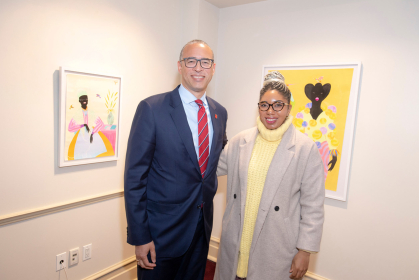Old Navy Taps Mason Gross Graduate to Design Black History Month T-Shirt
Artist Grace Lynne Haynes was discovered on Instagram by the clothing retailer

Less than a month after earning her MFA from Mason Gross School of the Arts, a T-shirt Grace Lynne Haynes designed for Black History Month hit the racks at Old Navy.
Haynes is the latest artist of color to partner with Old Navy’s Project We graphic tee series celebrating diversity. The shirt showcases her signature style: a Black female figure outfitted in bold colors and surrounded by fanciful birds.
“The faces of the women are not specific. I feel like anyone can see themselves in the women in my paintings,” Haynes said of her work. “I really like birds because they represent freedom. Particularly for Black women, it’s important to find ways to be free in our everyday life.”
The opportunity to collaborate with the global retailer came in August when 15 Percent Pledge founder Aurora James spotted Haynes’ work on Instagram. Launched in 2020, the 15 Percent Pledge encourages retailers to reserve 15 percent of their shelf space for Black entrepreneurs.
Old Navy embraced the 15 Percent Pledge this summer, donating $500,000 to the nonprofit and expanding its Project We series.
“The 15 Percent Pledge was a huge part of me saying yes. They have collaborated with so many artists of color in the past, so I knew this was a legit project I wanted to be a part of,” said Haynes, 30. “Even in our Zoom conversations, they were very sensitive to the topic and wanted to make sure it represented me as an artist and a Black woman.”
After James shared one of Haynes’ designs with her Instagram followers, Old Navy spotted it and asked Haynes to participate in Project We. She submitted three designs for their consideration. The one the clothing store selected is now a bestseller.
“I hope it makes those wearing it feel empowered,” she said of the T-shirt that she can be seen sporting on Old Navy’s site and Instagram stories. “And I would hope it would stimulate their imagination somewhat.”
This isn’t the first time Haynes’ work has been shared with wide audiences. In 2020, two of her paintings made the cover of The New Yorker: a portrait of a Black woman in a fabulous outfit with an equally fabulous bird perched on her right palm; and a highly patterned portrait of 19th-century abolitionist, former slave, and women’s rights crusader Sojourner Truth flanked by hummingbirds. The originals hang in President Jonathan Holloway’s offices.

Her first taste of commercial and critical success – including her being featured in Forbes’ “30 Under 30 in Art and Style” – came as Haynes was embarking on her master’s program at Mason Gross. But the New Brunswick resident said she is thankful she didn’t withdraw from the program to capitalize on the moment.
“There was a part of me that knew I had much to learn,” said Haynes, who studied commercial art as an undergrad. “The honest feedback I received from peers and professors helped me understand the importance of always being open to trying something new or tweaking something or inventing a new part of my process.”
Coming into an MFA program after receiving public exposure isn’t easy, said Heather Hart, an assistant professor in Art and Design at Mason Gross, who instructed Haynes during her first semester, mentored er and sat on her thesis committee during her final year.
“It’s hard to feel you can experiment when the world is already expecting a certain thing from you. But the space Grace was able to carve out for herself here yielded some new and exciting developments for her,” said Hart, noting her collaboration the American Repertory Ballet. “She was really able to loosen up, understand the historical underpinnings of her work and be more self-aware, intentional and open. Going forward, I imagine her doing amazing things: museum shows, collaborations, residencies, public interventions. She has just begun.”
Haynes said the MFA experience helped her take risks, refine her voice as an artist, understand the psychology of color and verbalize her work with more clarity. Next up, she plans to move to Brooklyn to explore new fashion collaborations and gallery opportunities.
Maybe someday, one of her pieces will hang in the Zimmerli Art Museum, she muses. But for now, she is reveling in her Old Navy moment and what it means not just for her as an artist of color, but for Black women and girls around the world.
“I remember one of my professors at Rutgers said to make art for the little girl in you. What would that little girl see? What would she need to see?” she said. “I feel so blessed to live in this time where we are open to different artists of different backgrounds. When I saw my little cousin in my shirt, it was so inspiring. I hope it helps little girls to know what’s possible for them too.”


